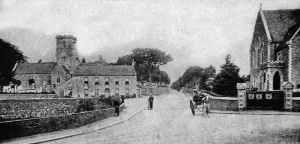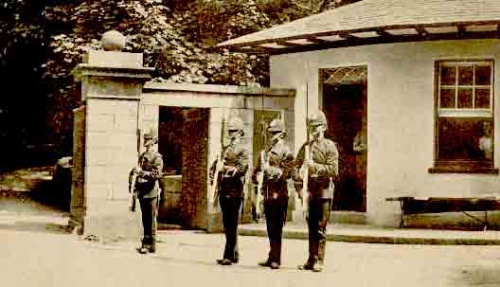The area around St Saviour's Church has been an important part of island life for many years. Landmark buildings integral to parish life, such as the church itself, Government House and the parish hall are all nearby.
Road rerouted
On the Richmond Map of 1795 properties were scant. Apart from the church and a few scattered dwellings, the area was dominated by agricultural fields and orchards. The road up the hill towards the church ran straight through what are now the grounds of Government House.
By the time the 1849 Godfray Map was produced, the road had been rerouted to today's layout. A note in the parish roads committee minutes for March 1810 records that a new military road was being built and that the old road, known as Ruelle Sacrament, would no longer need to be open to the public and could be sold into private ownership.
Church repairs
The church is the oldest building in the area. it has stood for many centuries, but by the late 19th century it was in a state of disrepair. In 1894 noted architect and engineer Adolphus Curry was approached to put together a report on the state of the building.
The parish assembly accepted the findings of the report and Blampied and Le Mottee undertook repair work for £660.
Further work was undertaken in 1902 after a piece of the ceiling fell down. Curry reported that certain areas of the church were unsafe as a result of settlement of the foundations. The assembly voted £2,000 for essential work.
Some parishioners objected to the plans on the basis that the work was to be paid for from a loan which would be subsequently reimbursed through the parish rates. A law suit claimed that the assembly had no right to vote that money be used for the purpose and that it was out of their jurisdiction to raise a loan.
Frederick Stephen Roberts took an appeal to the Privy Council, but the Council agreed that the parish had a right to make this decision.
Land in front of the cemetery was sold by the church to Francois Payn in April 1811 to build a public house which was to become St Saviour's Hotel. The hotel was originally built and used by the Laurel Party, so it is possible that the Rector at the time was a supporter, and that was why he was open to selling the land for this purpose.
After Payn's death the hotel passed to his daughter Elizabeth, who bequeathed it to her son Philippe Le Maistre.
The hotel was at the centre of parish life throughout the 1800s. The parish hall was built in the late 19th century from a design by Adolphus Curry. The foundation stone was laid in July 1890. Before then parish meetings and public elections were held in the hotel.
By the 1880s Elie Falle was landlord, with his wife Jane, nee Lempriere, succeeding him after his death. [1]
With the parish hall built, the death knell was sounded for St Saviour's Hotel. In 1893 Mrs Falle lost her licence to sell alcohol. She was recommended to receive another one by the majority of parishioners at a parish assembly, but when she went before the Licensing Assembly of the Lieut-Governor, Bailiff and Jurats, her application was rejected. The Lieut-Governor had written a letter of complaint over the unsanitary conditions of the property. A further application the following year was also turned down.
Mrs Falle converted the hotel to a grocery, but that did not necessarily stop her from carrying on her pub business, sometimes with unfortunate consequences. She appears a number of times in the Honorary Police records for the illicit sale of alcohol.
She died on 17 November 1908, aged 82, at the hotel, which was then bought by Canon Luce on 13 March 1909. The parish reimbursed him for the mortgate on the property and the building was demolished and the land incorporated into the cemetery.
Murder
There was a murder near St Saviour's Rectory in 1906. The body of a man was found in a field close to Swan's Farm, tenanted by Edward le Cornu.
The dead man was identified as Frenchman Pierre Le Guen, native of Ploezal. [2] he had been struck with a rock, which was found at the scene.
Thomas Connan, brother-in-law of the deceased, was quickly arrested and he implicated his sister, Marie Francoise Le Guen, nee Connan, as the culprit. He admitted hitting Le Guen, but only after having been encouraged by his sister, and after she had struck the first blow.
When confronted with the fact that her brother had admitted the charges and had incriminated her, Marie said that he had left her house on the night of the murder at 10 o'clock with a knife. She said she had told him not to do anything foolish, and that he returned the following day covered in blood.
The brother and sister were tried for murder at the January Assizes in 1907. Both of them pleaded 'not guilty' but the jury found Connan guilty of murder and his sister guilty of aiding and abetting him in the crime. She was sentenced to 20 years penal servitude and Connan was condemned to be executed - a sentence that was carried out in Newgate Street Prison on 19 February 1907.
Government House
Government House has been close to St Saviour's Church since the 1820s. Before that the Lieut-Governor's residence was in Halkett Place. Successive Lieut-Governors had complained about their accommodation and Major General Sir Colin Halkett decided that he needed to move.[3]
He arranged an exchange with the then owner of Belmont, where Government House is now situated, exchanging the town property, together with a field called St Clement's Meadow, for the St Saviour building. The owner of Belmont agreed to pay for a guardhouse to be built in preparation for the Lieut-Governor moving in.
In 1989 the Island Development Committee decided that the building was in such a dilapidated state that the best course of action would be to demolish it and start again. They had not anticipated the passionate defence of the building by local and national groups, leading to a petition of 10,000 signatures and a letter of support from the Queen Mother.
On 16 January 1990 the committee reversed their position and the States voted by 37 votes to eight to save Government House.
Notes and references
- ↑ Elie, born in St Saviour in 1827, the son of merchant George and Jeanne Esther, nee Ahier, was a blacksmith when he married Jane Elizabeth Lempriere, daughter of Josue Abraham, in 1850.
- ↑ A commune in the Cotes d'Armor department of north Brittany
- ↑ The irony is that having insisted that he did not want to live on the corner of King Street and the new road leading off it, Sir Colin's name was given to the road



